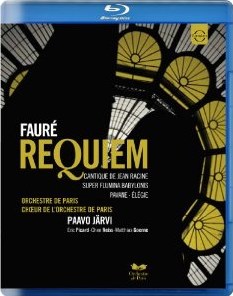|


alternatively
CD:
AmazonUK
AmazonUS
|
Gabriel FAURÉ (1845-1924)
Choral and Orchestral Pieces .
Pavane for orchestra and choir in F sharp minor, Op. 50,
(1891) [6.44]
Elégie for cello and orchestra in C minor, Op. 24,
(1883) [7.23]
Super flumina Babylonis (Psalm), for choir and orchestra.
(1863) [11.00]
Cantique de Jean Racine, for choir and orchestra in D flat
major, Op. 11, (1865) [6.08]
Requiem for soprano and baritone, choir, organ and orchestra
in D minor, Op. 48. (1888-1900) [37.31]
 Chen Reiss (soprano); Matthias Goerne (baritone); Éric Picard
(cello); Philippe Aïche (violin solo)
Chen Reiss (soprano); Matthias Goerne (baritone); Éric Picard
(cello); Philippe Aïche (violin solo)
Choir of the Orchestre de Paris/Stephen Betteridge; Orchestre de
Paris/Paavo Järvi
rec. live, Salle Pleyel, Paris, February 2011
Picture format: 1080i 16:9
Sound formats: PCM Stereo, DD 5.1, DTS 5.1
Region code, all (worldwide)
Subtitles: Latin, German, English, French
Booklet notes: English, German, French
 EUROARTS 2058874
EUROARTS 2058874  [72:00 + 15:00 bonus]
[72:00 + 15:00 bonus]
|
Born in Pamiers, France, in May 1845, Gabriel Fauré was
encouraged by his family in his early musical ambitions. He
shared this with Paavo Järvi the idiomatic conductor of
these performances. Fauré trained at the École
Niedermeyer, Paris, coming under the influence of Camille Saint-Saens.
After completing his studies he became organist at St. Saveur
in Rennes and there found time for composition. In 1871 he returned
to Paris as assistant at St. Sulpice and later moved to the
larger and more prestigious Madeleine. Composing and teaching
supplemented his income and in 1882 he was employed as a teacher
of composition at the Conservatoire where his pupils were to
include Ravel, Enescu and Nadia Boulanger. He was appointed
Director in 1905 and remained in that position until 1920, his
administrative duties severely restricting his compositional
creativity.
Undoubtedly a Romantic and with an enthusiasm for Wagner and
Liszt, Saint-Saens was Fauré’s prime influence.
He attempted some large-scale compositions. He became more self-critical
and later restricted himself to smaller forms in which he excelled
particularly when allied to his gift for melody. The opening
Pavane (CH.2) was originally for orchestra with the choral
parts added later. Like the Elégie (CH.3) it was
very much a product of his early compositional period. Its gentle
melody moves between lower strings to violins with wind following
the haunting theme. The conclusion has full orchestra with the
chorus soaring and then concluding sotto voce. It perfectly
illustrates the composer’s idiom and style. In this performance
of the Elegie the cellist Eric Picard plays the delicate
phrases to near perfection.
The seemingly unknown piece here, Super flumina Babylonis,
(CH.4)is an early work. In the bonus interview conductor
Paavo Järvi claims it as a world premier recording. I am
not wholly sure if he means on DVD or more generally. It is
certainly a rarity whose structure foretells much of the direction
the composer’s music for choir and orchestra would take.
Järvi certainly gives the music full value with members
of the Choir of the Orchestre de Paris filling in some solo
lines.
The main focus of the concert is the Requiem (CHs.9-16).
Detesting Berlioz’s super grandiose Grande Messe des
Morts, Fauré’s creation is elegiac in the extreme.
He began the work in 1877 and the first performance was as a
liturgical piece in 1883 at the Madeleine. At that stage there
were only five movements. The two involving the baritone soloist,
the Offertoire (CH.7) and Libera me, (CH.11) were
added later. The orchestrated version dates from 1900.
In this performance of the Requiem the chorus really
come into their own under Järvi. Good as they have been
earlier, here they excel. Baritone Matthias Goerne sings with
beautiful even tone and phrases with a delicacy that complements
the music to perfection. The Pie Jesu (CH.9) is sung
with excellent purity of tone by the soprano Chen Reiss. She
nearly obliterates from my mind’s ear the treble voice
of Jonathan Bond in that memorable recording by the Academy
of St Martins under George Guest (Decca).
Robert J Farr
|

